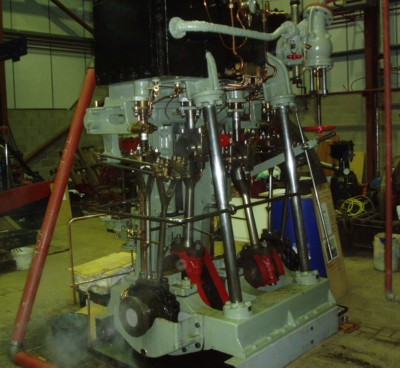
| Museum News 2005 |
|
(Back to Archive News Page) |
|
January 2005 Yarwood Vertical Compound Marine Engine No. 193 (Out of the dredger 'SEIONT II). Restoration work has now been completed on this engine. A temporary steam supply and exhaust system has been fitted for a trial run. At first it was difficult to start but once a 'technique' had been established it ran reasonably well, albeit a little bit uneven. The reason for this could be low steam pressure due to the temporary steam supply. Reversing rotation is also difficult but this may improve when more steam is available.
|
| The Yarwood compound marine engine in steam for the first time. |

|
|
New Arrivals
Two more engines have arrived for restoration - both on loan from Salter's Steamers Ltd. Oxford.
The initial loan period for these two engines is 2.5 years. |
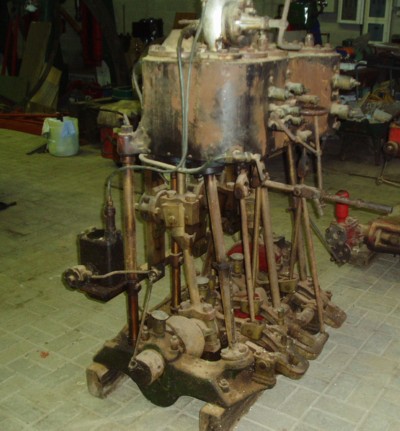
|
The Sissons triple expansion engine No.3113 as arrived from Salter's |
| The Plenty & Sons Ltd. triple expansion engine No.2518 as arrived from Salter's |

|
|
Reliant Paddle Tug, Side-Lever Engine
Although the paddle wheel arms (spokes) and the original small ring had some identification letters ( A to H) marked on them, as far as could be seen, their relative positions in the hub slots were not marked. The spokes would have been individually fitted to the hub so there was only one way they could have gone back - but which way??
The next challenge, for the restorers, was the fitting of the wooden paddles. Some new pivot pins had to turned in the lathe and most of the existing ones were re-machined (corrosion had eaten into the surfaces). New bearing were also turned from solid nylon bar and individually fitted to each paddle. All paddles have now been fitted. Work is now concentrated on the paddle feathering mechanism. The original mechanism would have been anchored to the side of the tug, but in our case a fabricated steel structure has had to be designed and is under construction. To help with this work a car wheel and tyre was fitted to the output shaft of an electrically driven reduction gear. This assembly was bolted directly underneath the paddle wheel with the tyre in contact with the outer rim. with this arrangement the paddle wheel could be easily rotated to the best position for fitting the paddles etc.
|
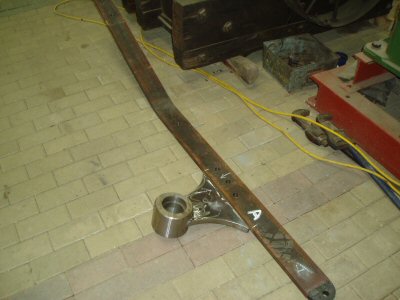
|
A new paddle wheel spoke with bearing housing ready for welding.
Eight of these were required. |
|
On the right is the central hub for the feathering mechanism - all the paddles will be linked to it.
On the left can be seen some bearing brackets. |
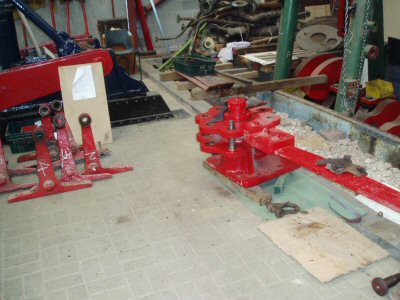
|
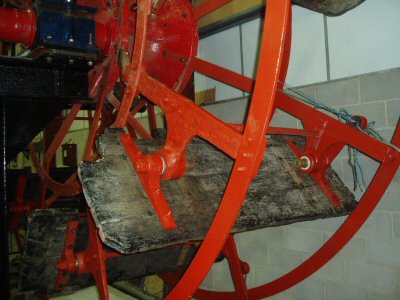
|
A paddle mounted on the paddle wheel. |
|
The temporary driving mechanism for the paddle wheel.
NOTE!! the guard was removed to take the photo. |
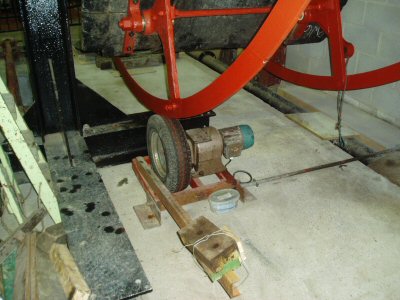
|
|
CD Holmes Triple Expansion Marine Engine, (out of tank cleaning vessel, 'Tulipbank')
Nov 2005
|
|
Horizontal Engine, on loan from Bradford Industrial Museum
This engine came to us on loan from Bradford Industrial Museum in March 2003 (see Museum News 2003). Soon after arrival some intial work was carried out, such as covers removed for inspection of cylinder, piston and valve etc.
In early December I took pity on the engine and started to revive it!, making use of the working space provided by the new block paved area. The engine had originally been mounted and running on a wooden base made from railway sleepers bolted together. This was a most unstable arrangement and upon inspection of the main bearings, excessive and uneven wear was revealed, due to misalignment.
|
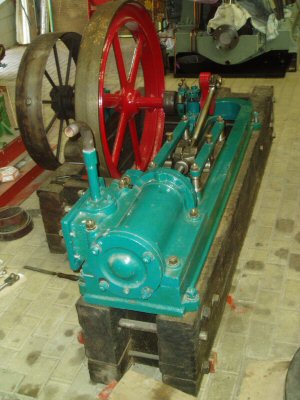
|
Horizontal engine from Bradford Industrial Museum, sitting on its railway sleeper base. |
| The engine stripped down, showing piston and piston rod etc. |

|
|
Arrival of Weir Boiler Feed Pumps
During November two boiler feed pumps, built by G&J Weir Ltd., Glasgow, were rescued from The Retreat Hospital on Heslington Road, York, who have kindly donated them to the Museum.
|
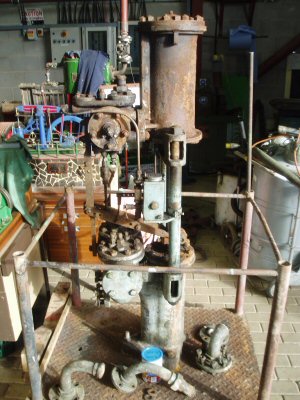
|
One of the Weir Direct-Acting Feed Pumps from The Retreat Hospital. |